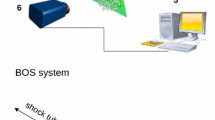Abstract
When a shock wave leaves an open-ended shock tube, it generates a vortex ring that subsequently detaches from the shock tube and follows the expanding shock front. This classical problem of shock–vortex interaction has been visualized in unprecedented detail and temporal resolution by means of time-resolved shadow, schlieren and shearing interferometry sequences obtained with a newly developed ultrahigh-speed color video camera. This device is capable of taking 144 frames with full-frame resolution of 720 × 410 pixels at rates of up to one million frames per second. Apart from shadowgraphy, the visualization techniques used in this study were direction- and magnitude-indicating color schlieren and polychrome shearing interferometry. The process was observed both with the standard normal view of the flow field and with an oblique view, which facilitated the identification of some three-dimensional flow features. The obtained results clearly show the development of individual flow elements, including some that so far have eluded a proper description. One example is the secondary, counter-rotating vortex ring, which at a later time wraps around the main vortex ring before disintegrating upon merging with the shear layer that surrounds the gas exiting from the tube.
Graphical abstract






Similar content being viewed by others
References
Baird JP (1987) Supersonic vortex rings. Proc R Soc Lond A 409:59–65
Brouillette M, Hébert C (1997) Propagation and interaction of shock-generated vortices. Fluid Dyn Res 21:159–169
Chang SM, Chang KS (2000) Visualization of shock–vortex interaction radiating acoustic waves. J Vis 3(3):221–228
Cords PH (1968) A high resolution, high sensitivity color schlieren method. SPIE J 6:85–88
Elder FK, de Haas N (1952) Experimental study of the formation of a vortex ring at the open end of a cylindrical shock tube. J Appl Phys 23:1065–1069
Etoh TG, Poggemann D, Ruckelshausen A, Theuwissen A, Kreider G, Folkerts H-O, Mutoh H, Kondo Y, Maruno H, Takubo K, Soya H, Takehara K, Okinaka T, Takano Y, Reisinger T, Lohmann C (2002) A CCD image sensor of 1 Mframes/s for continuous image capturing of 103 frames, In: Technical digest of international solid state circuit conference, IEEE 0-7803-7335-9/02, pp 45–48
Kainuma M, Havermann M, Sun M, Takayama K (2005) Effects of the shock tube open-end shape on vortex loops released from it. In: Proceedings of the 24th international symposium on shock waves, Springer, Beijing, 2004, pp 505–510
Kleine H (2001) Flow visualization. In: Ben-Dor G, Igra O, Elperin T (eds) Handbook of shock waves, vol 1, Chap 5.1. Academic Press, San Diego, pp 685–740
Kleine H, Settles GS (2008) The art of shock waves and their flowfields. Shock Waves J 17(5):291–307
Kleine H, Ritzerfeld E, Grönig H (2003) Shock wave diffraction at a ninety degree corner. CFD J 12(2):142–158
Kleine H, Ramasundara S, Fien A (2008) Density-sensitive flow visualization of three-dimensional flow fields. In: Proceedings of 13th international symposium on flow visualization (Nice), paper 112 (CD proceedings)
Merzkirch W (1987) Flow visualization, 2nd edn. Academic Press, Orlando
Minota T (1998) Shock/vortex interaction in a flow field behind a shock wave emitted from a shock tube. In: Takayama K, Jiang Z (eds) Proceedings of the 2nd international workshop on shock–vortex interaction, Tohoku University, Sendai, pp 149–160
Minota T, Nishida M, Lee MG (1997) Shock formation by compressible vortex ring impinging on a wall. Fluid Dyn Res 21:139–157
Oertel H (1966) Stossrohre. Springer, Wien, pp 713–722
Ohtake H, Hayashida T, Kitamura K, Arai T, Yonai J, Tanioka K, Maruyama H, Etoh TG (2006) 300,000-pixel ultrahigh-speed high-sensitivity CCD and single-chip color camera mounting this CCD, NHK Broadcast Technology no. 28
Settles GS (2001) Schlieren and shadowgraph techniques. Springer, New York
Skews BW (1967) The perturbed region behind a diffracting shock wave. J Fluid Mech 29(4):705–719
Sun M, Takayama K (1997) The formation of a secondary shock wave behind a shock wave diffracting at a convex corner. Shock Waves J 7(5):287–295
Acknowledgments
We would like to acknowledge the excellent technical support provided by Mr. Michael Jones of UNSW@ADFA, who designed and manufactured crucial parts of the shock tube used in these tests. We are also indebted to Prof. Beric Skews of the University of the Witwatersrand, who provided valuable advice at the beginning of the study. Finally, it is a pleasure to acknowledge the assistance of Mr. David Maclucas (University of the Witwatersrand), who participated in the first trials of this test series.
Author information
Authors and Affiliations
Corresponding author
Rights and permissions
About this article
Cite this article
Kleine, H., Vo Le, C., Takehara, K. et al. Time-resolved visualization of shock–vortex systems emitted from an open shock tube. J Vis 13, 33–40 (2010). https://doi.org/10.1007/s12650-009-0009-2
Received:
Revised:
Accepted:
Published:
Issue Date:
DOI: https://doi.org/10.1007/s12650-009-0009-2




